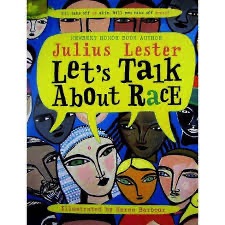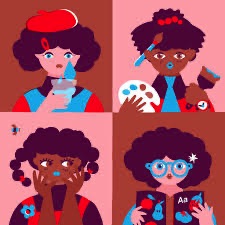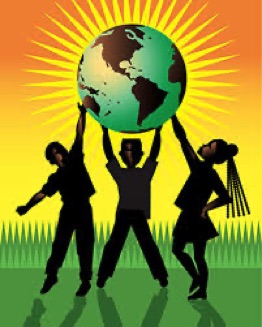Dear Kindergarten Families,
On this page, please find multiple resources I have found from blogs, websites and more. In May of 2020, several parents asked me for some suggestions for talking with their child. I decided to put together this page. If you come across something you'd like me to share, or you think is helpful, please let me know.
FROM PBS Kids Website:
How to Talk Honestly With Children About Race and Racism
In the aftermath of the murder of George Floyd and in the midst of protests around the country, we’re again left wondering what we should say to our children about racism in America. What is too much? What is not enough? What if they’re too young and we scare them? What if we’re scared, too
Children are never too young to learn about diversity. As young as 3 months old, they may look differently at people who look like or don’t look like their primary caregivers. As parents and caregivers, we must have confidence in ourselves and in our children — that we, and they, can handle tough topics and tough situations. We must understand that our role is to be honest, specific, and trustworthy as we raise the next generation to confront racial injustice.
CLICK HERE TO VIEW FULL ARTICLE Below Are A Few Excerpts from the Article.
Here are tips and resources to help you have a meaningful conversation with young children about race, racism, and being anti-racist.
Practice what you want to say before you say it.
A big struggle we have when it comes to addressing racism with our children is that conversations about race can bring up fear, uncertainty and discomfort for us, too. “Have these conversations with another adult first,” says Dr. White. Calling up a friend, another parent from school, or a family member to practice will help you become comfortable with what you want to say. Try to imagine questions your child might ask, and be ready to answer those questions, as well.
Be aware of your own biases.
“Really what children pay attention to is adult behavior,” says Dr. White. “You can talk incessantly with your child, but if you behave in ways that demonstrate you are fearful of people of color, fearful of Black people, or if your children are growing up in an all White neighborhood and you don’t expose them to people of color — children do notice that. They notice your body language. And they listen to what’s being said around them.”
Use picture books.
Notice what your child might be learning about race from their favorite stories. If all the characters in a book look the same, ask what your child thinks about that. If the characters are diverse, ask something like, “which character would you want to be friends with?” Dr. White says you might be shocked by their answers, but try not to react with judgment. The goal is to understand what your child knows, doesn’t know, and what they might already think about race. Then you can help your child learn by asking more questions and preparing yourself for more conversations in the future.
Ask your child how they feel — directly.
You know your child best — so be aware of their emotions, then consider asking if there is anything they are worried about or afraid of. If your child is worried about being hurt, you can explain how you will protect them. And if they’re worried about you being harmed, let them know what steps you will take to stay safe. (“It’s important to me that I be a helper by going to the protest. I will hold my sign and be kind to others. If I think it’s not safe, I will leave and come home.”)
Answer “Why does this keep happening?” with an activity.
Take out some string and have your child wind and tie themselves up — maybe even looping your hands together with their hands. “Then, talk about the fact that racism and oppression and discrimination has been building for a long time. It’s really tangled and layered,” just like your hands will look, says Dr. White. You can talk with your child about how long it will take to untangle the string and untangle racism. (“Even if we get one knot out, there will be more left, and we have to keep working at it.”)
Instill confidence in Black children through storytelling.
Dr. White says one of the most important things parents can do is make sure Black children hear from you and others they love that their skin, hair, and facial features are beautiful. This can help build confidence in the way they look.
Then, you can support that confidence with storytelling. This is core to the work of Dr. White and the P.R.I.D.E. Program. Simply surrounding your child at home with books, magazines, pictures, and cultural artifacts that feature Black people can lead to improved problem-solving skills, improved behavior in school, and a greater ability to remember facts and information. Reading books about Black leaders like Martin Luther King, Jr, Rosa Parks, and Ruby Bridges can help support a positive racial identity, says Dr. White. And diving into books that represent Black families in everyday life can be racially affirming, as well. (Try picture books like The Snowy Day or Peter’s Chair.)
Help children begin to understand how to be an ally.
With school-aged children, Dr. White says you can start to have conversations about standing up for your friends and classmates. She suggests an activity created by an educator in the P.R.I.D.E. Teacher Cohort:
Try reading IntersectionAllies: We Make Room for All, and ask your child what they would do if they saw characters in the book being made fun of, or called names, or bullied. At the end, you can have your child write out a sentence or draw a picture about how they can be an ally and who they can be an ally to. This can be “a step toward children thinking about what they can do as a young child who might not feel like they have a lot of power — but they do,” says Dr. White.
ALSO FROM PBS:
Find More Resources
13 Children’s Books About Race and Diversity
VIDEO FOR CHILDREN: YOU MATTER, Read along with Christian Robinson
How Black Art Can Spark Conversations with Children
WATCH: Virtual Event - Talking to Children Authentically about Race and Racism
MORE VIDEO LINKS FOR KIDS TO WATCH
I Am Human I Am Human - A Book of Empathy, children's book read aloud, is written by Susan Verde with art by Peter H. Reynolds. This kids book read aloud is a sweet reminder that we are all human.
VIDEO FOR CHILDREN: YOU MATTER, Read along with Christian Robinson
Teaching Young Children About Bias, Diversity and Social Justice (Eutopia site)
Resources Shared by Parents:



